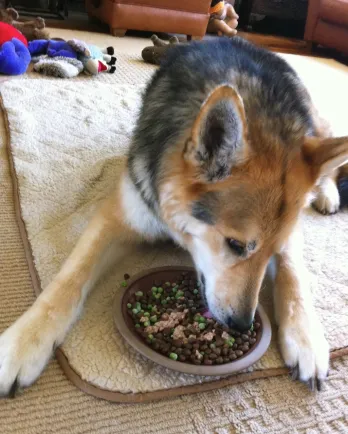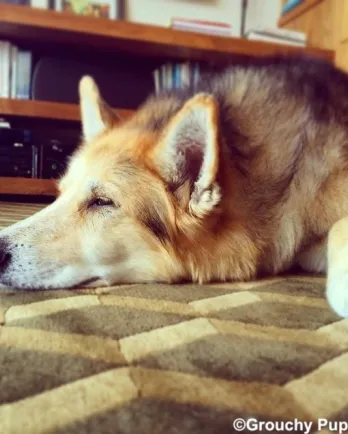Sweet Senior Girl: After Our Dog’s Diabetes Diagnosis by Sharon Castellanos
Writer Sharon Castellanos is the San Francisco-based publisher of Grouchy Puppy, a site devoted to celebrating and exploring the animal-human bond, and inspired by Cleo, her adopted Husky-Shepherd mix. You can read more about Cleo, Sharon, and Grouchy Puppy in a Grey Matters interview.
Choosing to adopt an older dog gave us immediate joy. She was smart, somewhat trained, and a giant sponge ready to soak up our love. She also came with her name, Cleo. We didn’t need to change a thing about her, only build up her confidence and trust in us as her permanent family unit. We learned about each other every day as we lived our life together in San Francisco.
Cleo was always a little on the sensitive side. She had a sensitive nature, and a stomach that was the opposite of Henry’s, the Labrador next door with the iron pit of one. According to our neighbor, Henry ate as many rubber bands and socks, as he did bowls of kibble. I appreciated Cleo’s delicate qualities because you knew right away when she wasn't feeling well, emotionally or physically. We learned quickly what foods she liked, how she liked affection displayed towards her, and when she needed to go outside.
As Cleo began to move through her senior years, I watched her diet and exercise closely. As a large Shepherd-Husky dog, it was important to monitor her for age-related signs of distress to her hips, and to watch her weight. We discovered her food sensitivity also included being allergic to several common foods and pollens. After we adjusted her diet, Cleo quickly returned to her playful, energetic self.
The Diagnosis
Cleo started showing signs of vision problems when she was about 7-8 years old. It was in her eighth summer with us that she became diagnosed with diabetes. One afternoon, we noticed Cleo drinking a lot of water. I mean, she drained her bowl like she had just spent an hour at the beach.
I watched her for a day, before going online to do some research, then I called my vet. He said to observe the amount of water Cleo was drinking, and note any changes to her behavior. I wrote down each time she went to her water bowl. Her increased water consumption was the only significant change in her ways. I was tempted to take away her water an hour before we went to bed because I didn’t want her to have an accident, nor did I really want to get up in the middle of the night to take her out. Even with a big dog like Cleo, I tried to avoid going out after midnight with her in the city. My vet said that we should let Cleo drink as much water as she needed but if she continued drinking this much water, she might have diabetes and we’d need to get her glucose checked.
After a couple days with no change, our vet next instructed us to follow Cleo outside in the morning and catch her pee in a container, then bring it quickly to their office. My husband brilliantly slipped a saucer under Cleo just as she squatted. We sacrificed a plastic container for secure transport. It didn’t take long for the test to come back positive for diabetes. Honestly, I was slightly crushed. We had just gotten her allergies under control, and now this!
Treatment for Diabetes
The diabetes diagnosis also meant we would need to give Cleo insulin injections twice a day. Did I mention she was a Shepherd-Husky dog? With a triple fur coat, according to the groomer?
You could say it was our good fortune that this diagnosis came after many years together. Cleo couldn’t have been more patient as we climbed the learning curve of administering insulin injections. Pulling back all that fur to find her skin was laughable, but we naturally used a tiny treat afterward to encourage her calm behavior.
As we settled into our new normal, we revisited her diet to make sure it was appropriate for a diabetic dog. The book, Dr. Pitcairn's Complete Guide to Natural Health for Dogs & Cats helped. It came recommended as a respected source for holistic treatments. I reduced the amount of fat, carbs, and sugars, and added nutritional yeast and oat bran to her meals. Nutritional yeast helps control blood sugar levels, which is critical for a diabetic dog.
Cleo had earlier shown she is allergic to rice and wheat, thus adding oat bran was important as a healthy source of good fiber. We added coconut oil and green veggies, but stopped giving her additional fresh squash out of concern of adding too much sugar to her diet. Many of the treats we gave her already had squash as the key ingredient, partnered with chicken or salmon.
Diabetic Shock
Besides dialing in her diet, giving her the right foods, it is crucial that you feed a diabetic dog at the same time every day. To keep her blood sugar levels steady, she needs to eat on a regular schedule. You can find yourself in trouble if it’s raining buckets outside, and you are an hour behind schedule because a certain dog doesn’t want to get her butt wet, or she is giving you a sweet sleepy face. This happened to us about a year after Cleo’s diabetic diagnosis. I still carry a small amount of guilt in my heart, believing I could have prevented what happened to her.
It had been a sleepy morning for all of us. Cleo didn’t seem to be in a hurry to get up, and it was a cold, blustery February day. Believing that we could stretch her window between meals an extra hour, we indulged without thinking ahead of possible consequences. From the day we brought her home, Cleo told us when she was hungry, when she wanted to play or if she needed to go out. Why stop now? It had been over a year, and Cleo’s glucose levels had been constant. It had been many months since we had upped the amount of insulin we were giving her. Every dog is unique but we learned that morning that an hour delay of her meal, added to her walk around the block to pee and poop, was too much.
I will never forget the feeling of the electrical currents running through Cleo’s legs, or the confused look on her face. It felt like an hour that we comforted her, all three of us confused by what was happening. The tremors coursing through her body lasted about ten minutes. We took Cleo to the closest emergency 24-hour pet hospital that morning. She came out of it like the super dog we believed her to be, but it’s a cautionary tale that I will never forget.
Afterwards, this is what I found on VetInfo.com: A diabetic shock occurs in dogs that are diagnosed with diabetes, and indicates a condition determined by a low level of glucose in the blood or hypoglycemia. The condition may be caused by:
- An overdose of insulin, if you administer too much, or the prescribed dose is too high.
- Excessive exercise that causes a decrease of the glucose levels in the blood.
- If the dog skips a meal, this will result in an immediate drop in the blood sugar; even a one-hour delay of the meal may result in low levels of glycemia.
- Excitement may also lead to a diabetic shock.
Cleo survived this experience, but her left eye became sunken, with its third eyelid red and raised. The vet believed the diabetic shock contributed to the development of Horner’s Syndrome. These symptoms lasted for weeks, and occasionally returned for about a year.
What We Learned
There is joy to be found in a diabetic dog. As time passed, my father who also had diabetes took to calling Cleo his dog, and I believe found inspiration from her life. I developed a deep empathy for my father’s struggle, something I could appreciate firsthand thanks to Cleo. We found ourselves educating a lot of friends and strangers. Yes, dogs can develop diabetes, and yes, they can still live a long and happy life. With love overriding any squeamishness, I became a whiz at using a needle to give her insulin shots.
The best part about this story is that it’s one more example of how loving a dog, especially an older dog, will always triumph. Our love for Cleo was greater than the hurdle of a diabetes diagnosis. She continued to demonstrate wonderful life lessons and reminded me that no matter what, diabetic or not, older dogs can positively influence your life.
You can read more from Sharon Castellanos at www.grouchypuppy.com.
The Grey Muzzle Organization improves the lives of at-risk senior dogs by providing funding and resources to animal shelters, rescue organizations, sanctuaries, and other nonprofit groups nationwide.





